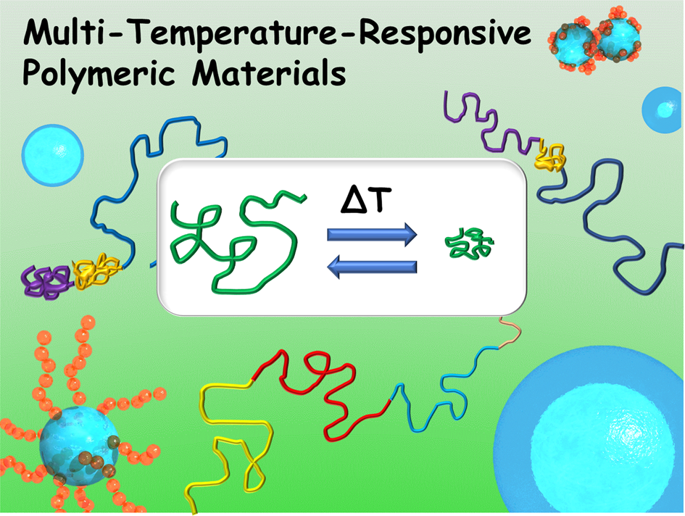Our official English website, www.x-mol.net, welcomes your feedback! (Note: you will need to create a separate account there.)
Recent advances in multi-temperature-responsive polymeric materials
Polymer Journal ( IF 2.8 ) Pub Date : 2020-03-24 , DOI: 10.1038/s41428-020-0330-0 Yohei Kotsuchibashi
Polymer Journal ( IF 2.8 ) Pub Date : 2020-03-24 , DOI: 10.1038/s41428-020-0330-0 Yohei Kotsuchibashi

|
Temperature-responsive (or thermoresponsive) polymers belong to the most studied class of smart polymers and are mainly classified into two types based on their temperature-responsive behavior: lower critical solution temperature (LCST) and upper critical solution temperature (UCST). Based on polymeric design, when two temperature-responsive segments are connected through a covalent bond at each chain end, the block copolymers are expected to show a dual-temperature-responsive property upon conformational changes. Moreover, in recent years, multi-temperature-responsive properties that can represent complex states/structures have been reported. These multi-temperature-responsive block copolymers can set the stage for development in various research fields, such as drug-delivery carriers, sensors in solvents, model proteins, and memory storage. This review focuses on current multi-temperature-responsive polymeric materials and their applications and is divided into three parts: (1) dual-temperature-responsive block copolymers, (2) dual-temperature-responsive hydrogels, and (3) multi-temperature-responsive block copolymers. Temperature-responsive (or thermoresponsive) polymers belong to the most studied class of smart polymers and are mainly classified into two types based on their temperature-responsive behavior: lower critical solution temperature (LCST) and upper critical solution temperature (UCST). Based on polymeric design, when more than two temperature-responsive segments are connected through a covalent bond, the block copolymers are expected to show a multi-temperature-responsive property upon conformational changes. This review focuses on current multi-temperature-responsive polymeric materials and their future applications such as drug-delivery carriers, sensors in solvents, model proteins, and memory storage.
中文翻译:

多温度响应聚合物材料的最新进展
温度响应(或热响应)聚合物属于研究最多的一类智能聚合物,根据其温度响应行为主要分为两类:下临界溶解温度(LCST)和上临界溶解温度(UCST)。基于聚合物设计,当两个温度响应链段通过每个链端的共价键连接时,嵌段共聚物有望在构象变化时表现出双温度响应特性。此外,近年来,已经报道了可以表示复杂状态/结构的多温度响应特性。这些多温度响应嵌段共聚物可以为各种研究领域的发展奠定基础,例如药物输送载体、溶剂中的传感器、模型蛋白质和记忆存储。本综述着重于当前的多温度响应聚合物材料及其应用,分为三个部分:(1)双温度响应嵌段共聚物,(2)双温度响应水凝胶,以及(3)多温度响应-响应性嵌段共聚物。温度响应(或热响应)聚合物属于研究最多的一类智能聚合物,根据其温度响应行为主要分为两类:下临界溶解温度(LCST)和上临界溶解温度(UCST)。基于聚合物设计,当两个以上的温度响应链段通过共价键连接时,嵌段共聚物有望在构象变化时表现出多温度响应特性。
更新日期:2020-03-24
中文翻译:

多温度响应聚合物材料的最新进展
温度响应(或热响应)聚合物属于研究最多的一类智能聚合物,根据其温度响应行为主要分为两类:下临界溶解温度(LCST)和上临界溶解温度(UCST)。基于聚合物设计,当两个温度响应链段通过每个链端的共价键连接时,嵌段共聚物有望在构象变化时表现出双温度响应特性。此外,近年来,已经报道了可以表示复杂状态/结构的多温度响应特性。这些多温度响应嵌段共聚物可以为各种研究领域的发展奠定基础,例如药物输送载体、溶剂中的传感器、模型蛋白质和记忆存储。本综述着重于当前的多温度响应聚合物材料及其应用,分为三个部分:(1)双温度响应嵌段共聚物,(2)双温度响应水凝胶,以及(3)多温度响应-响应性嵌段共聚物。温度响应(或热响应)聚合物属于研究最多的一类智能聚合物,根据其温度响应行为主要分为两类:下临界溶解温度(LCST)和上临界溶解温度(UCST)。基于聚合物设计,当两个以上的温度响应链段通过共价键连接时,嵌段共聚物有望在构象变化时表现出多温度响应特性。



























 京公网安备 11010802027423号
京公网安备 11010802027423号